Make mine a triple
Three-wheeling in the Black Hills
Piedmont, S.D., August 7—As dyed-in-the-wool two- wheelers, our history with trikes has been quite limited. However, as the riding population has begun to explore the three-wheeled world, our curiosity grew accordingly, so we decided to try out a couple of trikes during this year’s Sturgis rally.
Balancing our desire to enjoy the widest range of triking experience against the limited time we had available, we selected the monster of the bunch, the Boss Hoss, and the newest and most petite three-wheeler—the Ridley.
To trike, or not to trike?
I’ve never had any affection for three-wheeled motorcycles. They’ve always seemed an aberration to me, a contradiction to the essence of biking. They don’t even fall into the normal realms of evolutionary progress—you go from a four-wheel baby stroller, to a tricycle, to a bicycle, with each one requiring an increased skill level. Why would I want to regress and ride a trike? I like the idea of owning a powerful machine that can’t hold itself up and requires me, a mere human, as its stabilizer. I relish being part of a sport that if you’re not moving forward, you’re falling down, just like surfing or piloting an airplane. And then to toss in an automatic transmission makes the reasoning even more difficult. I like shifting, and down shifting, and power shifting and burnouts and wheelies—all the neat teenage hooligan stuff that is part and parcel of a manual transmission. But these trikes are sure becoming popular. So with an urgent desire to remain in vogue with biker chic, I swallowed my two-wheeled prejudice, tied my clutch hand behind my back, left my sense of balance at the curb and saddled up.
—Robert Filla
Big bad boss
Just like many of you, I’ve observed the Boss Hoss demo trucks at many motorcycle rallies. I’ve never had the nerve to try out one of those 1,100-pound eight-cylinder two-wheeled gargantuas, but the three-wheeled variety seemed promising because I figured I wouldn’t drop the trike at slow speeds.
Being a child of the ’50s, I chose the quite striking BHC-8 LS2 ’57 Chevy Trike. As the name implies, it takes its styling cues from the venerable ’57 Chevy. The model I rode was a snazzy two-toned number in aqua and white with pinstriped accents on the headlight, tank, and tailfins, and just enough chrome to make it sparkle. Hidden in the trunk was six cubic feet of storage space—more than one can find on even the biggest full dresser.
Not only was this the first Boss Hoss I’d ever been on, it was the first trike I’d ever ridden. I expected something clunky, sluggish, and hard to handle, and was quite surprised when the opposite proved to be true. I could talk about seat height (29″) and weight (1,455 pounds), but those types of specs didn’t matter to me because I was on three wheels and didn’t have to put my feet on the ground until I was ready to dismount.
In spite of my fear of falling, I quickly learned that the 35-degree rake combined with the weight distribution over the three wheels provides great stability, and I soon found myself taking corners at normal riding speeds. The ride itself was smoother than expected, probably due in part to the air ride suspension that our test model was equipped with.
The Chevy engine in the LS2-powered ’57 is a whopping 364 c.i. that puts out 425 hp at 5750 rpm and 425 ft/lbs at 4750 rpm. With all those horses under the hood, I wanted to see how it would perform. So, on a deserted Black Hills road, I punched it (I sure hope the Boss Hoss folks aren’t reading this) and held on tight. This big boy goes from 0–60 mph in about three seconds. What a rush! That kind of power comes with a price, though. At an estimated 21–25 mpg, the ’57 gets only slightly better mileage than a Corvette. The ’57’s 12-gallon tank provides at least a 250-mile riding range, and the seating and floorboard ergonomics are so comfortable for both rider and passenger that stretch breaks in between refueling stops probably aren’t necessary.
The automatic transmission has three forward speeds and a reverse speed that has a safety mechanism preventing accidental shifting into reverse. Four-piston calipers, both front and rear, provide enough stopping power for this heavyweight machine. Of course, I had to test the brakes, so I jammed them on (I’m still hoping the Boss Hoss staffers skip this section). The ’57 stopped quickly and efficiently, hardly skidding at all. The beefy 275/50R-15 rear tires and 130/90-16 in front helped keep the trike on track, as well.
For 2009, Boss Hoss has discontinued the LS2 model and replaced it with the LS3 that houses the same engine that powers current Corvette models. The LS3 is 376 c.i. (think 6200cc compared to the V-twin engine sizes you’re familiar with!), and it puts out 445 hp and 445 ft/lbs. My understanding is that the difference isn’t noticeable to the average rider.
Suggested MSRP for the LS3 ’57 Chevy base model is $54,500. Custom two-toned paint with trim, much like the model we rode, adds between $2,500 and $3,000 to the base price, and the optional air ride suspension will set you back another $1,600.
—Shadow
Putting the Boss back into Hoss
The initial appearance leads one to believe that the Boss Hoss is one brute of a machine. And true, it is intimidating, wide and heavy, but it also possesses a smoothness of power that is intoxicating. Due to the huge mass of the bike and the tall gears of the three-speed transmission, the ’57 has what is often described as “vibration-free acceleration.” And when that fluid momentum is combined with the bike’s almost graceful handling characteristics, all thoughts of a barbaric ride come to an end. The thing is so smooth that it’s very easy to get a little too comfortable and exceed acceptable riding speeds. And I can’t imagine the new 2009 LS3 engine being an improvement over the previous LS2. But then I guess when you’re talking about displacements of this magnitude, bigger is better, especially when marketing to a cubic-inch-hungry customer base (“I’ve got 0.2 liters more than you do”).
The seating position proved to be quite comfortable although getting off and on continued to be an awkward procedure to someone who has swung a leg over a two-wheeler on a daily basis for more than 40 years. The expansive gas tank has no bearing on riding position but its dizzying array of instruments will be the delight of any gauge freak. The controls are easily managed but once again, old training continued to surface as I often found myself searching for a clutch lever. But I was having so much fun that I actually didn’t even miss the shifting action. Concerning that earlier mention of almost graceful handling, there are a few instances when riding the LS2 ’57 might be compared to wrestling a pregnant hippo. Due to the Trike’s 5′ width and almost 11′ length, 180-degree turns have to be planned well in advance and often require the use of reverse and a second attempt. Also, the same triangular design that gives the Trike such stable tracking and solid command of the highway can, on uneven surfaces (like a set of railroad tracks) cause the rear suspension to react with a shuffling motion, resulting in a set of shimmying handlebars. This oscillation occurs only at low speeds and is caused by the basic geometry of a “delta” design (one wheel in front, two behind) responding to road conditions.
The LS2 ’57 has its own unique beauty, like a locomotive with custom paint and chrome. And the accessories are extensive with a large portion of them being performance-enhancing. It’s an enjoyable ride that commands respect from both zealots and the contemptuous. In the end, about the worst thing I can say about the Boss Hoss LS2 ’57 is… yeah, but it’s still a trike.
—Robert Filla
Ride, Ridley, ride
There was nothing intimidating about the Auto Glide Trike. It looked like a lot of fun to ride, and I wasn’t disappointed. That baby zips around like nobody’s business.
The turning radius actually seemed smaller than on a regular bike (at 97″ in length, it’s slightly more than 4″ longer than my Dyna Super Glide), maybe because you could lock the handlebars at low speeds without worrying about losing your balance and falling over.
The electric reverse is probably the fastest on the market and will shoot you back quite a ways if you’re not prepared for the quick response. The Ridley weighs only 760 pounds, so it was recommended that we just dismount and push it backwards instead. It worked like a charm.
And speaking of charm, the Auto-Glide Trike’s got plenty. The model we tested was a real head-turner. Its glistening white chassis with red flame treatment attracted lots of attention and plenty of admiration.
—Shadow
Riddle me this
What dances on three feet, is as heavy as a Road King and cute as an ice cream truck? That would be Ridley Motorcycles’ new Auto-Glide Trike. Derived from their two-wheeled Auto-Glide Classic introduced in 2002, the Ridley Trike is the latest in the company’s lineup, being introduced this year. Powered by the company’s proprietary 90-degree V-twin engine, this is an air-cooled unit, having a displacement of 738cc. It has two valves per cylinder, 8.5:1 compression ratio and receives fuel via a single carburetor and branched manifold. A set of twin pipes handle the exhaust gases, merging together under the frame and exiting through a common muffler under the rear body section. The “750,” which is the largest engine ever offered by Ridley, kicks out 39 horses. The Trike comes in at a dry weight of 760 pounds and a GVWR of only 1,110 pounds. Adding in 4.2 gallons of petrol (the tank’s full capacity), two quarts of oil and a 235 pound test gorilla means the only gal I could pick up had to come in at 90 pounds or less. But since the Auto-Glide Trike doesn’t have a passenger seat, that really wasn’t a consideration—unless I could talk her into climbing into the bike’s spacious trunk.
The true appeal to those enraptured with this bike is its low seat height (a mere 24.5″ off the tarmac) and its automatic Continuously Variable Transmission (CVT), also a Ridley proprietary unit. Although the CVT is not new (Leonardo da Vinci conceptualized a stepless CVT in 1490), Ridley has refined this process of power transfer so at take-off the lowest gear ratio is 6:1, ending with a 17 percent overdrive. This final drive ratio allows the Ridley Trike to cruise at 80 mph while only turning an indicated 3850 rpm. And yes, the Auto-Glide Trike will go 80 mph, although it will take you a while to get there. Once up to speed, it seems content to churn away all day. You won’t be winning many races with this bike (unless you’re racing another Ridley) but for those who are interested in clutch-free riding and not neck-snapping acceleration, this just might be the answer. The bike must be started with one of the brakes applied (a built-in safety feature) and from there, take-off is a simple twist-and-go operation. Once you reach a predetermined rpm, the CVT kicks in and you are rolling. The sensation feels a little weird, but after a bit it becomes tolerable. It will be a dream for anyone who has never ridden a bike.
The handling is solid with the fat 16″ tire up front leading the way for the pair of 225/60-15″ rears, which is backed up by an exceptional turning radius, making around-town navigation a breeze. And whatever the power plant may lack in horsepower is more than made up for in the trike’s styling, with every South Dakota female I encountered wanting a ride (something’s gotta be done about that missing passenger seat).
—Robert Filla
Triking off into the sunset
Besides the novelty of trying a new mode of motorcycle transportation, there were a few more practical reasons for our awakened interest. Using the reverse gear on the Boss Hoss, or just pushing the Ridley backwards, instead of having to muscle a bike out of a tight spot appealed to us, as well as the stability offered on uneven and challenging surfaces such as the dirt-and-gravel roads that snake through the Black Hills.
And let’s not forget that we’re getting older, with both of us having passed the half-century mark a few years back. Automatic transmissions rather than manual clutches sure take the stress off those arthritic joints. The trike could be the perfect solution for those riders who are edging their way into their golden years.
When we think back to our trike tryst in Sturgis, though, these practicalities aren’t foremost in our minds. What we remember is tearing around the back roads and highways, enjoying the curious—and envious—glances that other riders cast our way. The fact is, triking is sheer fun, and just another way to enjoy our sport.


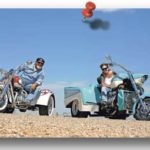
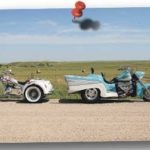
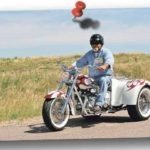
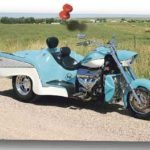
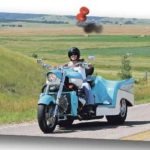
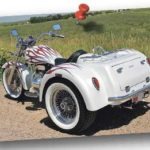
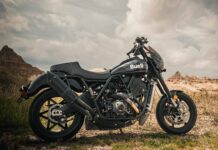
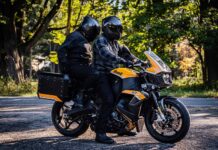
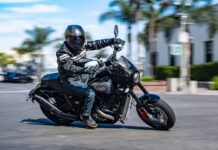
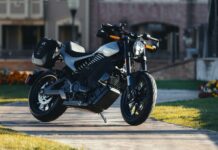
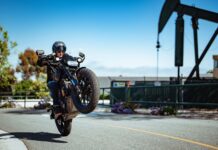











Iterested..in the turquoise blue 57 Chevy trike…do you have one available?